How to cover a gas stove: options and instructions for finishing the wall near a gas stove + safety measures
Having started a kitchen renovation, we often think about how to cover a gas stove so that the coating will last for many years and will not lose its appearance after the first cleaning.
Agree, finishing a working wall in the kitchen is not an easy task and requires compliance with a number of conditions. After all, cooking is a process that has a strong impact on the exterior of the kitchen: there are splashes of fat, water, and steam. Over time, all this may not have the best effect on the external cladding.
Next, we will tell you what materials can be used to cover the wall behind a gas stove. And we will understand the intricacies of their installation. We provide step-by-step instructions, accompanied by visual photos and useful videos.
The content of the article:
Materials for decorating an apron
Quite high demands are placed on materials for cladding kitchen walls. After all, housewives spend a lot of time in the kitchen preparing food. Therefore, it is very important that the environment is not only pleasing to the eye, but also practical.
Thus, materials for protecting walls from a gas stove must have the following characteristics:
- Moisture resistance. Everyone knows that humidity in the kitchen is always at a high level - steam during cooking, splashes of hot and cold water. All this can negatively affect finishing materials with low moisture resistance.
- Heat resistance. Near a gas stove, the walls always heat up, and quite strongly.Therefore, constant exposure to high temperatures can have a bad effect on wall coverings.
- Hygiene. In conditions of high humidity, bacteria multiply at incredible speed. Therefore, for the cooking area you need to choose a coating that will not absorb anything.
- Mechanical strength. This is one of the main requirements for finishing materials for the kitchen. The work area (apron) will be cleaned regularly. And it is very important to choose a material that will allow you to remove dirt without much effort.
- Aesthetics. In addition to all the above requirements, the material for kitchen walls should look organically in the interior, because the kitchen is a place where every housewife spends a lot of time. You should also immediately take care of masking gas pipes.
Having dealt with the requirements that are put forward for materials for finishing the kitchen work area, we will talk about the materials themselves that are used for this purpose.

When thinking about how to cover the wall behind a gas stove, most often people choose ceramic tiles. This material is famous for its aesthetic qualities and affordable price.
The tiles do not absorb grease and other contaminants, so cleaning them is not difficult. In addition, the material has increased resistance to temperature changes and is not afraid of household chemicals.And the variety of shades and textures allows you to create the perfect design of your dreams.

The only drawback of ceramic tiles is the complexity of their installation, but we will talk about this a little below.
PVC film. It can also be used for cladding walls behind a gas stove. This is a fairly cheap type of polyvinyl chloride coating. The film can be textured or glossy, with or without a pattern. And you can buy it at almost any hardware store.
But, in essence, this is a one-time coverage option. After all, this material has extremely low wear resistance. It is more suitable as a temporary solution. For example, when you need to cover a more expensive finish.
We looked at the best ideas for wall decoration in this photo collection.
Mirror behind the gas stove it looks bright and unusual. The mirror panel is easy to clean from dirt and has good resistance to moisture and high temperatures. This solution will fit into the interior of almost any kitchen.
Mirror coating also has disadvantages. The main one is the complexity of installation. In addition, in order for the mirror coating to look stylish and aesthetically pleasing, you need to constantly keep its appearance clean.Therefore, be prepared for the fact that after each cooking, the mirror apron will have to be wiped clean of dirt.
Stainless steel, as a finishing material, is also popular. Its surface can be matte, glossy or patterned. Steel has strength, durability, resistance to moisture and temperature changes.
This material is quite expensive, so in order not to spoil the coating during the first cleaning, it is worth considering that it should be cleaned only with the use of special, non-abrasive cleaning products.
Tree behind the gas stove it looks stylish and noble. This is perhaps one of the most environmentally friendly materials for wall decoration. But, before choosing this option, it is worth considering that such finishing will be very expensive. In addition, for proper installation it is impossible to do without the involvement of specialists, and this will also cost a tidy sum.
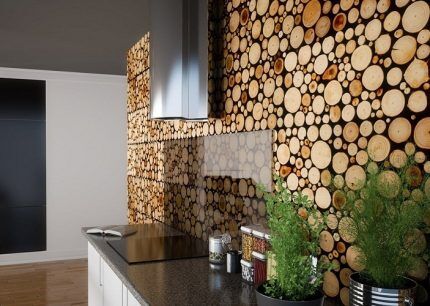
Natural and artificial stone – this group includes many materials, and not all of them can be used to decorate the walls behind the kitchen stove. Among the materials suitable for this purpose, it is worth noting clinker tiles, granite, basalt and porcelain stoneware.
When choosing such materials for finishing a kitchen apron, you should take into account the high cost of the coating itself and its installation, as well as the fact that if the lining is damaged, it will have to be completely replaced, since it cannot be repaired.
Listed above are the traditional methods for finishing the wall behind the stove, but in addition to them, there are alternative options that you can do with your own hands. More about this in the next photo gallery.
As you can see, there are a lot of options for finishing the walls behind gas stoves. You can choose a classic design, or you can create a masterpiece from scrap materials with your own hands. The decision should be made based on your preferences and financial capabilities.
Wall finishing instructions
Next, we will look at several simple ways on how you can cover the wall behind a gas stove yourself. What materials and tools will be required for this.
Option No. 1 - installation of ceramic tiles
Decorating a kitchen work wall with ceramic tiles is one of the most popular and widespread options. Of course, you can entrust this work to professionals, or you can try to do everything yourself.
But, before you start finishing the walls near the gas stove, we recommend that you familiarize yourself with the progress of the upcoming work.

First you need to calculate how many tiles you will need for the backsplash. To do this, you need to measure the height and width of the apron itself, not forgetting to take into account the dimensions and hood location over the gas stove.
The number of tiles will depend on their size and installation method. Considering possible errors in calculations and the possibility of spoiling the material, it is better to play it safe and take tiles 10% more than the calculated quantity.
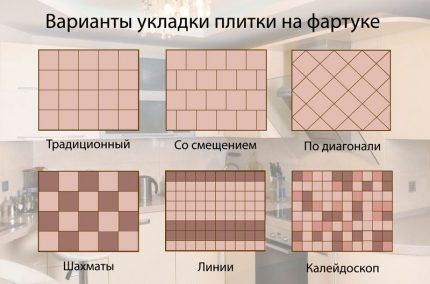
Having purchased the required number of tiles, you can begin preparing the tools for work.
To prepare and cover the walls you will need to use:
- Hammer. It may be needed if there is old coating on the walls.
- Screwdriver. For mixing the adhesive composition. You just need to take care of a special nozzle in advance.
- Bucket. It is better to take a spacious plastic bucket with a volume of at least 10 liters.
- Spatulas. To work, you will need a narrow one, with a serrated edge, and a rubber one.
- Building level. It will be used to check whether the tiles are laid correctly.
- Tile cutter. For trimming the edges of tiles if necessary.
In addition, you may need: a cord, a ruler and a pencil, a rubber hammer, crosses for installing tiles, grout and, directly, the adhesive composition itself.
Having prepared all the necessary tools and materials, you can begin finishing work.
After all the tiles have been laid, all you have to do is wait until the adhesive has dried, then remove the crosses and grout the joints using a rubber spatula.
As you can see, the process itself is not as complicated as it might seem at first glance.
Option No. 2 - decorating a wall with a glass screen
A worthy alternative to a protective screen made of ceramic tiles would be to use special tempered glass. This material will reliably protect the walls near the stove from dirt, it is not exposed to moisture and high temperatures, and also has good wear resistance.
This is why many housewives choose a glass screen. Yes, and it looks very stylish.
Before starting work, it is necessary to measure the area of the wall on which the glass apron will be attached. It is better to double-check the accuracy of the measurements several times in order to avoid installation problems later if the product turns out to be a little larger/smaller than needed.
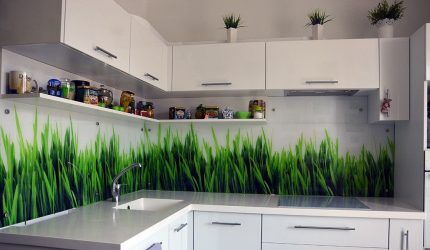
When ordering the production of glass for an apron, you should immediately specify the making of holes for fasteners. They must be at least 5 cm from the corners of the product.
The panels are quite large in size, so the wall on which they will be mounted must be perfectly flat so that the product fits tightly over the entire area.
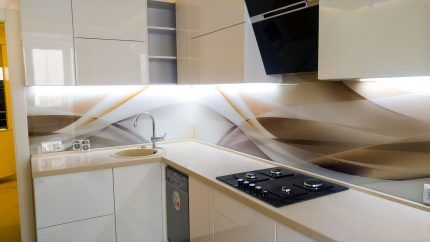
Before starting installation, you need to attach the finished apron to the wall and mark the location of the fasteners with a pencil. Next, using a hammer drill and a nozzle of the appropriate size, make holes for fasteners, insert dowels and anchors into them.
The next thing to do is to place the glass panel on the anchors and secure it with the fastening caps.
As you can see, even a novice home craftsman can handle installing a glass splashback. The main thing here is the accuracy of measurements and smooth walls.
Safety rules when choosing material
The most important thing in the design of a kitchen space is the correct choice of material for finishing the wall behind the stove, especially if the kitchen has gas equipment. In addition to splashes from cooking, this wall will be exposed to high temperatures.
Therefore, it is important that there is a heat-resistant material behind the stove. In this regard, ceramic tiles, glass, and metal have proven themselves well.
If the choice fell, for example, on MDF or PVC panels, then it is worth knowing that flammable materials cannot be mounted in close proximity to gas burners, so that such a decision does not backfire fire.
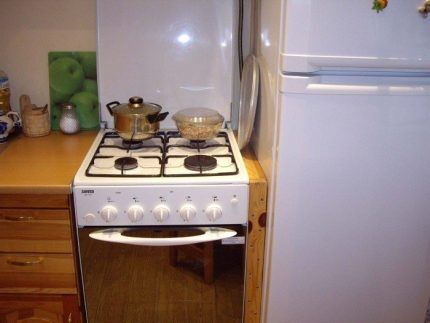
Also, do not forget that it is highly undesirable to place a refrigerator next to a gas stove. If such a proximity is inevitable, then it is worth laying a heat-resistant partition between the devices.
Insulating material is placed between the refrigerator and the stove. Insulation can save refrigeration equipment from overheating, but will not provide protection from grease.
Conclusions and useful video on the topic
How to install a glass protective screen yourself will be discussed in the following video:
Installation of a ceramic tile apron:
When choosing a protective screen for the wall behind a gas stove, you need to pay special attention to the choice of material. It should have good wear resistance, since it will be subject to regular cleaning using detergents.It is also equally important to comply with installation technology, because even the highest quality material will not last long if its installation technology is not followed.
On the market now you can find material for every taste and budget, so there should not be any difficulties with the choice.
Have you ever had to install an apron behind a gas stove yourself? Please share with our readers what material you chose and whether you managed to cope with the task. Leave your comments, share your experience, add photos of your kitchens in the discussion block.



